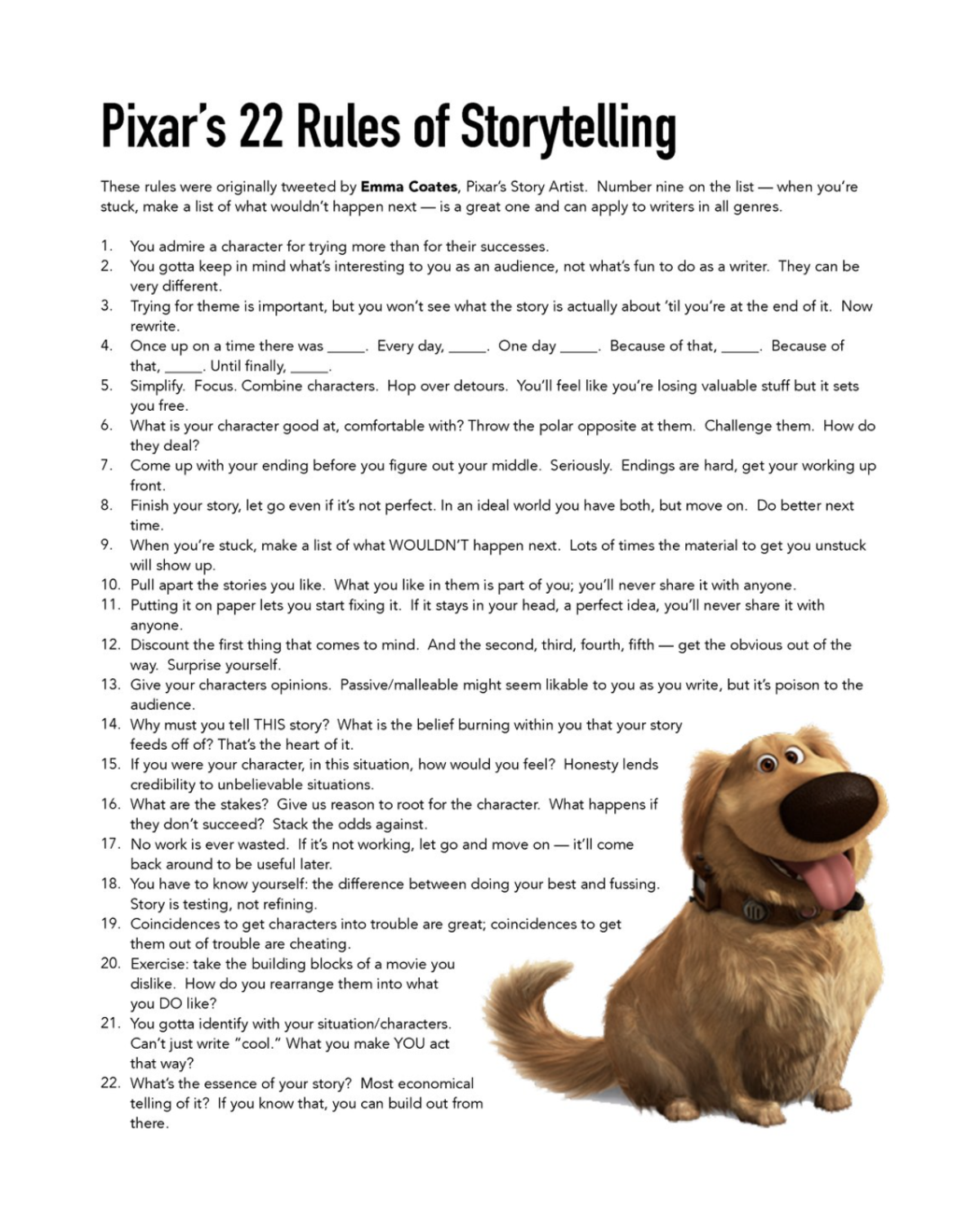
The Misguided Marriage of Superficial Story Rules and ChatGPT
Why throwing Pixar's "22 Rules of Storytelling" into AI isn't the shortcut to great storytelling you think it is
In the ever-evolving landscape of narrative theory and storytelling tools, a recent trend has caught my attention—feeding the renowned Pixar's "22 Rules of Storytelling" into ChatGPT to generate an "instant story." A recent tweet thread showcases this technique (currently listing over 600,000 impressions 😣), capturing the awe of aspiring writers. But let's not be fooled by the apparent magic here. This practice reveals not only a superficial understanding of storytelling but also exposes the limitations of using AI as a storytelling crutch when paired with drivel.
The Trap of Simplification
The "22 Rules of Storytelling" by Pixar are, without a doubt, catchy and easy to digest. However, this doesn't make them a one-size-fits-all blueprint for crafting a compelling narrative (it's something I've already covered here on Narrative First in Genius Doesn't Know Genius and Write with Confidence and Purpose). And now everyone is combining these rules with ChatGPT. That's like expecting to win a Grand Prix with training wheels on. The machine is only as good as the input it receives, and if that input is inherently flawed or superficial, you're in for a lesson in "garbage in, garbage out."
When an AI Even Struggles to Make Sense of These Rules
Let's start with Rule #1: "You admire a character for trying more than for their successes." ChatGPT responds,
Ole is not just a success story; he's a fighter who didn't give up when he almost lost everything.
Ok. How is that even remotely helpful in crafting a narrative? All ChatGPT did was repeat back what the rule said, but within context of this character Ole. I have no idea what drives Ole, why its a problem for him, what he was focused on instead that kept him from seeing his problem, nor do I have any indication of how that ties into the plot, how he grew out of it, or into it, and whether or not that was ultimately a good or bad thing for him.
In other words, I know nothing more than I did before using this "mega" prompt of the 22 Rules of Superficial Storytelling.
(But if I used Subtxt and Subtxt Muse, I would know the answer to all of these questions, and more.)
Let's try another one: "Trying for theme is important, but you won't see what the story is actually about til you're at the end of it. Now rewrite." This rule is categorically false, and proffered by someone who doesn't understand that you absolutely can know your theme before you've written a single word. Furthermore, they don't realize that the recent introduction of public access to LLMs only makes this process so effortless (Subtxt being the shining example), that to suggest otherwise is to gatekeep, and to keep writers lost in the endless morass of the "next draft."
Even ChatGPT knows this rule to be B.S. as it responds:
The theme seems to be resilience and transformation.
—which is a great start (proving the rule factually wrong, as the story hasn't been written yet). But the follow-up,
This will be clearer as we flesh out the story.
is just a re-write of the last half of the rule, that it's ultimately pointless.
Everyone can see that, right?
Chat doesn't even know how to respond to "When you're stuck, make a list of what WOULDN'T happen next", because it's such an inane rule that has no basis in context.
Not applicable here as the story is straightforward
is a cop-out, and just a probabilistic response to what is essentially a request to negate what doesn't exist in context.
And what about this gem? "Simplify. Focus. Combine characters. Hop over detours." Chat can only respond:
The focus is on Ole and his transformation. No need for additional characters or subplots.
Wow.
A couple more responses like this and I'm guaranteed to write the next Toy Story or Finding Nemo. 🙄
Missing the Mark on What Really Drives Narrative
All of these flaws in the rules and this process arise from a lack of understanding of what drives narrative. It's not about shortcuts or tweet-length tips. It's about the complex interplay of themes, motivations, conflict, and resolution. It's about the characters' journeys through these elements, and how that journey resonates with our innate understanding of problem-solving and human experience.
And there's only one tool that helps you establish and explore all of these areas of narrative.
Elevating the Conversation
As the tech world increasingly offers us tools that promise to make storytelling easier, it's more vital than ever that we hold ourselves to a higher standard. For those of us invested in the art and science of narrative, it's not just about rejecting the shallow; it's about actively working to deepen our collective understanding of what makes a story truly great. Let's ensure that these new tools add to that richness rather than dilute it into superficial nonsense.
Download the FREE e-book Never Trust a Hero
Don't miss out on the latest in narrative theory and storytelling with artificial intelligence. Subscribe to the Narrative First newsletter below and receive a link to download the 20-page e-book, Never Trust a Hero.



